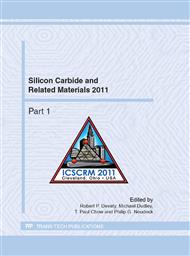p.617
p.621
p.625
p.629
p.633
p.637
p.641
p.645
p.649
Study of Epitaxial Graphene on Non-Polar 6H-SiC Faces
Abstract:
We present epitaxial graphene (EG) growth on non-polar a-plane and m-plane 6H-SiC faces where material characterization is compared with that known for EG grown on polar faces. AFM surface morphology exhibits nanocrystalline graphite like features for non-polar faces, while polar silicon face shows step like features. This differing behavior is attributed to the lack of a hexagonal template on the non-polar faces. Non-polar faces also exhibit greater disorder and red shift of all Raman peaks (D, G and 2D) with increasing temperature. This is attributed to decreasing stress with increasing temperature. These variations provide evidence of different EG growth mechanisms on non-polar and polar faces, likely due to differences in surface free energy. We also present differences between a-plane ( ) EG and m-plane ( ) EG in terms of morphology, thickness and Raman characteristics.
Info:
Periodical:
Pages:
633-636
Citation:
Online since:
May 2012
Keywords:
Price:
Сopyright:
© 2012 Trans Tech Publications Ltd. All Rights Reserved
Share:
Citation:



